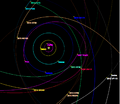Astronomy:2014 FE72
 Diagram showing the highly eccentric orbit of 2014 FE72 | |
| Discovery[1] | |
|---|---|
| Discovered by |
|
| Discovery site | Cerro Tololo Obs. |
| Discovery date | 26 March 2014 |
| Designations | |
| 2014 FE72 | |
| Minor planet category | |
| Orbital characteristics[2] | |
| Epoch 21 January 2022 (JD 2459600.5) | |
| Uncertainty parameter 3 | |
| Observation arc | 6.98 yr (2,549 days) |
| |{{{apsis}}}|helion}} |
|
| |{{{apsis}}}|helion}} |
|
| |
| Eccentricity |
|
| Orbital period |
|
| Mean anomaly |
|
| Mean motion | 0° 0m 0.055s / day |
| Inclination |
|
| Longitude of ascending node |
|
| |{{{apsis}}}|helion}} | ≈ 6 October 1965[4] ±11 days |
| |
| Physical characteristics | |
| Mean diameter | 270 km (est. at 0.08)[5][6] |
| Apparent magnitude | 24.3[7] |
| Absolute magnitude (H) | 6.19[2] |
2014 FE72 is a trans-Neptunian object first observed on 26 March 2014, at Cerro Tololo Inter-American Observatory in La Serena, Chile. It is a possible dwarf planet,[5] a member of the scattered disc, whose orbit extends into the inner Oort cloud.[1] Discovered by Scott Sheppard and Chad Trujillo, the object's existence was revealed on 29 August 2016.[1][8] Both the orbital period and aphelion distance of this object are well constrained.[2] 2014 FE72 had the largest barycentric aphelion until 2018. However, the heliocentric aphelion of 2014 FE72 is second among trans-Neptunian objects (after the damocloid 2017 MB7). (As of 2023), it is about 66 AU (9.9 billion km) from the Sun.[7]
Orbit
Orbits of 2014 FE72 (green, at lower left) and other scattered/detached objects, along with hypothetical Planet Nine on the right
Using the Solar System Barycenter as the orbital frame of reference, 2014 FE72's extremely elongated orbit (eccentricity = 0.98) has a perihelion of 36.1 AU, an aphelion of ~4,050 AU and a barycentric orbital period of ~92,400 years.[3] The latter values are the largest known for any Solar System body that is not a long-period comet.[n 1] Based on the barycentric orbital period, 2014 FE72 takes roughly 5 times longer than Sedna to orbit the Sun.[10]
2014 FE72 last passed through perihelion around late 1965.[2]
See also
- List of Solar System objects by greatest aphelion
- List of Solar System objects most distant from the Sun
Notes
- ↑ 2017 MB7, an apparently much smaller object (absolute magnitude ~14) which might be an extinct comet, has a similar barycentric aphelion of ~2,800 AU and an orbital period of ~54,000 years.[9]
References
- ↑ 1.0 1.1 1.2 Williams, G. V. (29 August 2016). "MPEC 2016-Q43 : 2014 FE72". Minor Planet Center. http://www.minorplanetcenter.net/mpec/K16/K16Q43.html.
- ↑ 2.0 2.1 2.2 2.3 2.4 "JPL Small-Body Database Browser: (2014 FE72)". Jet Propulsion Lab. Archived from the original on 5 February 2018. https://web.archive.org/web/20180205154630/https://ssd.jpl.nasa.gov/sbdb.cgi?sstr=2014FE72. Retrieved 26 August 2018.
- ↑ 3.0 3.1 3.2 3.3 3.4 3.5 3.6 3.7 3.8 3.9 Cite error: Invalid
<ref>tag; no text was provided for refs namedbarycenter - ↑ JPL Horizons Observer Location: @sun (Perihelion occurs when deldot changes from negative to positive. Uncertainty in time of perihelion is 3-sigma.)
- ↑ 5.0 5.1 Michael E. Brown. "How many dwarf planets are there in the outer solar system? (updates daily)". California Institute of Technology. http://www.gps.caltech.edu/~mbrown/dps.html. Retrieved 2016-09-15.
- ↑ "Absolute magnitude (H)". NASA/Jet Propulsion Lab. http://neo.jpl.nasa.gov/glossary/h.html. Retrieved 2016-09-15.
- ↑ 7.0 7.1 "AstDyS 2014FE72 Ephemerides". Department of Mathematics, University of Pisa, Italy. https://newton.spacedys.com/astdys/index.php?pc=1.1.3.1&n=2014FE72&oc=500&y0=2023&m0=1&d0=1&y1=2028&m1=1&d1=5&ti=366&tiu=days. Retrieved 31 October 2023. (Distance to Sun [R] from 2023 to 2028.)
- ↑ "Hunt for ninth planet reveals new extremely distant Solar System objects". Carnegie Institution. 29 August 2016. https://carnegiescience.edu/news/hunt-ninth-planet-reveals-new-extremely-distant-solar-system-objects.
- ↑ JPL Small-Body Database Browser: (2017 MB7)
- ↑ Cite error: Invalid
<ref>tag; no text was provided for refs namedSednaBarycentric
External links
- 2014 FE72 at AstDyS-2, Asteroids—Dynamic Site
- 2014 FE72 at the JPL Small-Body Database
 |



